

Chris Kluwe: How augmented reality will change sports ... and build empathy. Creating Augmented Reality for Education. The Augmented Web: Simplifying Augmented Reality In Education. The Augmented Web: Simplifying Augmented Reality In Education by Maria Politis, Head of Content and Community at buildAR If you spend time on twitter looking at the #augmentedreality and #edutech hashtags you will know that there is quite a lot of discussion going on about Augmented Reality, and how it can be used as an educational tool.
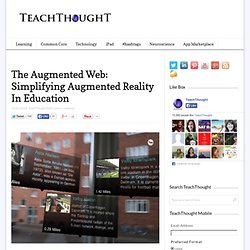
And with good reason. The web is full of innovative examples of how Augmented Reality is used in classrooms around the world every day. The ability to overlay digital content and information onto the real world, using triggers like images and locations opens up a world of rich learning opportunities. There is a wide range of Augmented Reality applications for the classroom currently available and real, practical uses of the technology are easy to find. Misunderstanding The Complexity. James Patten: The best computer interface? Maybe ... your hands. Mobile learning. John Dewey, writing in the early years of the twentieth century, may not have foreseen the proliferation of 21st century ‘mobile devices’ but, in the quotation to the right, he does point out something that remains relevant: that mobile learning involves change, initiative and adaptability.

Mobile learning involves change in the sense that the ability to communicate with tutors and peers, as well as access learning resources, changes what is possible in education. It takes initiative for leaders to create a vision to sustain that change and, finally, mobile learning requires adaptability by members of staff to carry out the change. This infoKit is a practical guide to thinking through the issues relating to institutional adoption of mobile learning. It follows a JISC Mobile and Wireless Technologies Review which delves deeper into the theory behind mobile learning and the wider context.
Emerging Practice in a Digital Age. Creating Augmented Reality for Education. The cARe project explores two examples of how Augmented Reality (AR) could be used to enhance learning.
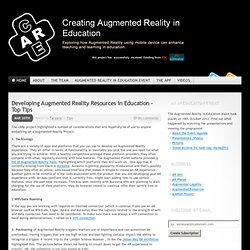
The examples focus on the use of AR with nursing students. Further details of the projects are described below. You can also watch the video that was used to describe the project. Example 1 – Clinical Skills Laboratory The first of these projects looked at the use of AR in supporting simulated practice. In this example a series of markers were set up around the laboratory. The essential resources were accessed before, after and during practicing a skills enabling students to reflect on their learning (experiential learning), work together (promoting collaborative learning and peer feedback) and at their own pace (self paced learning). To gain some initial student feedback a group of students were filmed as they used the technology and then asked to participate in a focus group.
Student Feedback The main insights from the focus group indicated that: Example 2 – Public Health Walk. L'Arbre des Possibles - Carte des Futurs. La carte des futurs interactive permet de visualiser les futurs possibles et les scénarios en relation avec ces futurs.
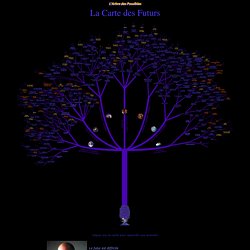
Sur cette carte, une arborescence de thèmes détaillés: exploration spatiale, voyages dans le temps, téléportation, lecture de la pensée, villes sous-marines, ordinateur bionique, fin du pétrole, prise de conscience écologique, spiritualité... A ces thèmes se raccordent des événements. Immersive Learning Experiences through Augmented Reality. Author: Judy Bloxham - Jisc RSC Northwest; Allen Crawford-Thomas - Jisc RSC West Midlands; Stephen Wileman - South Staffordshire College What is Augmented Reality?

Augmented Reality overlays the digital world over the physical world - thus ‘augmenting’ the real world experience. Today examples of AR use can be seen in museums where AR is used to bring objects to life or as wearable technology such as the Google Glass project. AR is not a new concept, in fact, it has been around since the 1990’s. Early examples of AR use in mass education made use of QR (Quick Reference) codes. AR and Pedagogy So how does AR relate to learning and what are the pedagogical arguments? Samsung wants to turn your hands into an augmented reality keyboard. Nanotechnologies La Révolution Invisible 3/3. Un homme presque parfait. Le transhumanisme: ce qui est possible n’est pas toujours souhaitable.
Transhumanisme. H+, un symbole du transhumanisme. Transhumanisme : aujourd’hui, l’Homme réparé. Credit : sous licence CC, par Kosmur.
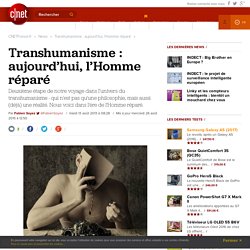
Deuxième étape de notre voyage dans l’univers du transhumanisme. Après vous avoir présenté ce mouvement qui entrevoit un futur où l’être humain pourra améliorer ses performances, voici venu le moment de vous prouver que le transhumanisme n’est pas qu’une philosophie, mais est aussi (déjà) une réalité. Car les transhumanistes s’appuient davantage sur les avancées techniques, que sur la science-fiction. Au premier plan, les progrès de la science liés à la médecine. Wearables: Frictionless learning (5 Levels of wearable learning)
This feels like the early days of mobile.
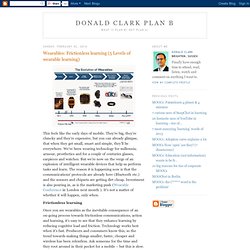
They’re big, they’re cluncky and they’re expensive, but you can already glimpse, that when they get small, smart and simple, they’ll be everywhere. We’ve been wearing technology for millennia; armour, prosthetics and for a couple of centuries glasses, earpieces and watches. But we’re now on the verge of an explosion of intelligent wearable devices that help us perform tasks and learn. The reason it is happening now is that the communications' protocols are already here (Bluetooth etc.) and the sensors and chipsets are getting dirt cheap. Investment is also pouring in, as is the marketing push (Wearable Conference in London next month ). Manu Prakash: A 50-cent microscope that folds like origami. Body Hacking. Pirater son corps et redéfinir l’humain !
Transformer le corps humain en faisant appel à la technologie, implanter dans le corps des composants artificiels, mixer le biologique et l’électronique, développer de nouveaux sens, augmenter les capacités humaines… telles sont quelques-unes des finalités du body hacking.

Portée par la recherche scientifique qui, depuis plusieurs décennies, cherche à tirer parti du numérique, de l’électronique et de la robotique pour guérir ou améliorer le quotidien de patients souffrant de pathologies et handicaps sévères, la démarche a évolué récemment. Aujourd’hui, ce sont des individus eux-mêmes qui poussent la logique de liberté individuelle à son paroxysme, en entreprenant sur leur propre corps des modifications physiques parfois extrêmes. L'homme augmenté.